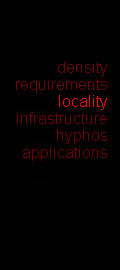The power of radio signals tends to fall off with the square of
distance. A popular wireless LAN system advertises a transmit range
of 200 meters. In contrast, a Hyphos node has a transmit range of
about 6 meters. This requires one thousand times less power than its
its LAN counterpart. Instead of milliwatts, a Hyphos node requires
microwatts.
If you think of limited transmit range as a limitation, consider this:
airwaves are a limited commodity -- they're not making any more of
them. When the aforementioned wireless LAN transmitter speaks, it
blankets over 125 thousand square meters. This is not a viable
approach for high-density networks.
Another way to think of this is in terms of fiber optic cable. One of
the key advantages to fiber optics is that you can run a lot of data
through a cable with a very small cross section. It wouldn't do much
good if a fiber optic cable was a meter in diameter.
So by localizing transmit range, you save power and conserve
bandwidth.



